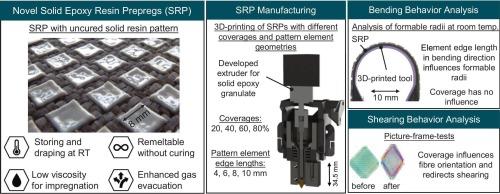Influencing the draping behaviour of solid epoxy prepregs by applying 3D-printed resin patterns
IF 7.9
2区 材料科学
Q1 MATERIALS SCIENCE, MULTIDISCIPLINARY
引用次数: 0
Abstract
This study presents a novel strategy to overcome the limitations of solid resin prepregs (SRPs) − namely the inability to drape at room temperature and hindered gas evacuation during vacuum-bag-only (VBO) processing − by 3D-printing a regular, uncured solid epoxy resin (SR) pattern on a dry woven textile. The locally patterned resin distribution preserves dry textile regions, enabling room temperature drapeability and more robust VBO-processing due to improved gas evacuation. By adjusting pattern parameters such as element geometry and coverage, the draping behaviour can be controlled to adapt to a desired draping condition. In order to be able to design the right pattern for given draping conditions, the influence of these parameters on bending and shearing was studied. Manual draping showed that bending radii down to 4 mm were achievable, governed only by the element length in bending direction, while coverage had no significant effect. In contrast, picture-frame-tests showed that the shearing is mainly influenced by the coverage and that a maximal shearing angle of 30° can be achieved. These results show that the SRPs bending and shearing can be independently influenced through pattern design. The derived structure–drapeability relationships enable targeted design of SRPs for robust, autoclave-free composite manufacturing.

通过应用3d打印树脂图案影响固体环氧预浸料的悬垂行为
本研究提出了一种新的策略来克服固体树脂预浸料(SRPs)的局限性,即在室温下无法悬空,并且在纯真空袋(VBO)加工过程中阻碍了气体的排出,通过3d打印在干燥的编织纺织品上打印出常规的、未固化的固体环氧树脂(SR)图案。局部图案的树脂分布保留了干燥的纺织区域,使室温下的悬垂性和更强大的vbo处理,因为改进了气体排出。通过调整图案参数,如元件几何形状和覆盖范围,可以控制悬垂行为以适应所需的悬垂条件。为了能够在给定的悬垂条件下设计出合适的图案,研究了这些参数对弯曲和剪切的影响。手工悬垂可以实现低至4mm的弯曲半径,仅受弯曲方向单元长度的控制,而覆盖度对弯曲半径的影响不显著。相框试验表明,剪切主要受覆盖范围的影响,最大剪切角可达30°。这些结果表明,通过图案设计可以独立地影响srp的弯曲和剪切。衍生的结构-悬垂性关系使srp的目标设计成为可能,以实现坚固,无高压灭菌的复合材料制造。
本文章由计算机程序翻译,如有差异,请以英文原文为准。
求助全文
约1分钟内获得全文
求助全文
来源期刊

Materials & Design
Engineering-Mechanical Engineering
CiteScore
14.30
自引率
7.10%
发文量
1028
审稿时长
85 days
期刊介绍:
Materials and Design is a multi-disciplinary journal that publishes original research reports, review articles, and express communications. The journal focuses on studying the structure and properties of inorganic and organic materials, advancements in synthesis, processing, characterization, and testing, the design of materials and engineering systems, and their applications in technology. It aims to bring together various aspects of materials science, engineering, physics, and chemistry.
The journal explores themes ranging from materials to design and aims to reveal the connections between natural and artificial materials, as well as experiment and modeling. Manuscripts submitted to Materials and Design should contain elements of discovery and surprise, as they often contribute new insights into the architecture and function of matter.
 求助内容:
求助内容: 应助结果提醒方式:
应助结果提醒方式:


